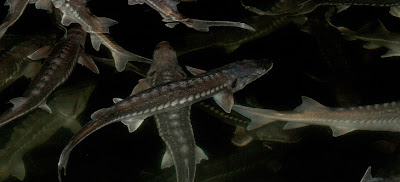 |
| Photo by Sterling Caviar |
I was privileged enough to recently meet Peter Struffenegger at a fundraising event. Struffenegger is the General Manager for Sterling Caviar and was gracious enough to allow this pushy blogger a fantastic opportunity - to watch them harvest and package fresh caviar.
 |
| Yowza! |
The United States' west coast is home to two of the 22 species of sturgeon: green and white. From these, California is producing 80% of U.S. Caviar. These bone plated fish have remained fundamentally unchanged for thousands of years. They can live to be over 100 years old and record ones have grown to be over 18 feet long and over 2000 pounds!
 |
| These tanks hold 1-2 year olds |
Once a year the breeding females are taken out and are biopsied to determine ripeness. The eggs used for spawning are ovulated from the female, induced to do so by the hormones. Being prehistoric fish, the sturgeon egg contains microphiles, holes in the egg thru which the sperm enters to fertilize the eggs. As ovulation takes place, the eggs separate from the ovarian membrane that holds them and the eggs become "open" to fertilization. "Each egg has a membrane that connects the egg to the female, similar to how an umbilical cord works in humans, feeding nutrients and oxygen into the egg, and as ovulation occurs, the egg separates from the membrane and is released into the water thru the oviduct," explains Struffenegger . Caviar, on the other hand, comes from un-ovulated eggs, where the hold that the membrane has on the egg and the connection to the ovary has to be physically separated in the processing plant.
The eggs are fertilized by the males' extracted sperm and a week later the tiny embryos hatch. These fish are now raised together in big tanks that are kept at a constant temperature from the warm well water provided to the tanks. In the wild, the sturgeon would eat well and grow a lot in the summer and then their metabolism and growth would slow during the winter. In these tanks there is no differentiation of seasons and they just eat and grow year round. Thus the farmed sturgeon will grow significantly faster than wild. In the wild it will take 15-20 years for a female sturgeon to mature. Farmed female sturgeon will mature in 7-10 years.
 |
| Picking out the largest fish |
The six year mark is when some of the females might be ready with caviar for harvesting. In the fall a biopsy is performed whereby a slit is cut into their bellies, a small tube is inserted and some eggs are sucked out. The eggs are examined for size and color to determine if they will develop enough to be harvested caviar in the spring. The fish are then sorted into tanks for this year's harvest and the rest are allowed to grow another year in hopes that they will be ready next year.
Caviar harvesting takes place from the end of January to the beginning of June. During that time only females are slaughtered, the eggs are processed into caviar, and the meat sold. The rest of the year the males are sorted, slaughtered, and sold.
Sterling actually has four facilities in the region. Each week staff at each facility will go through the tanks to find the largest fish. The fish are put into large oxygenated tanks and trucked to Elverta for processing.
This female is about 88 pounds. The caviar inside many of the Sterling sturgeon will account for about eight percent of their body weight. Older fish in the wild could have as much as 25% of their body weight as caviar!
The ovary sacs run from the back around the sides to the front of the fish on both sides. Each fishes' ovaries are placed into a single plastic bag. No fish ovaries are ever mixed with another. Any kind of cross contamination or adulteration is not allowed. The color, quality, and size of the caviar can differ considerably between fish and so to see any indication of mixing would ruin the reputation and the price of the product.
 |
| One half of this sturgeon's caviar |
The fish is then gutted, finned, and then either sold fresh within the US, or frozen to be shipped off for sale overseas .
 |
| Note the color difference between the two sets of caviar |
I asked Struffenegger about the metal I see touching the caviar. He explains that you should only use non-reactive metals or mother of pearl to handle caviar. "It's just easier to let the public think no metal than to have to explain which metals can touch it," Struffenegger said. Gold and mother of pearl spoons can be used when eating it, but here in the facility all the metal is stainless steel.
 |
| The different sized tins are in the background |
The cleaner eggs are now put into a tank that is filled with water. The flow of the water stirs the eggs so that they fall down and any remaining membrane floats up and out of the container. At the end of this step a small vacuum is used to suck up the last bits of membrane from the container. The eggs are then put into a sieve to drain.
Here the caviar from one sturgeon is being weighed. The weight is important because it will determine how many tins the caviar will fit in. There are six different sized tins and based on the weight the staff could pull a few different sizes that will equal what that weight will fill. The weight also determines the amount of salt that is added to cure the caviar. They use dendritic salt, which is a very fine, powdery mined salt. They add 4.5% of weight of the dendritic salt. The caviar then sits for ten minutes before it can be packaged. This allows the salt to pull out excess liquid to drain off.
Now the caviar grader comes to taste the caviar. There are three factors that the caviar is graded on. Each element is worth a point. First is the size of the eggs. Eggs between 3.2 -2.4 mm in diameter are given a point. Next are the "pop" and the taste. If the eggs pop well between your tongue and the roof of your mouth, they get a point. Then the taste will also receive a point - or not. The caviar now should have a grade of 0-3, which will determine the grade it receives: Classic, Royal, and if it is a Royal grade and is light in color, is graded as an Imperial,. Each tin will get a color dot that indicates what grade of caviar is in the tin. Even though color can vary from golden to black, it has nothing to do with quality and taste. "Color is purely a preference of the individual," explains Struffenegger.
 |
| photo by Sterling Caviar |
Currently Classic is sold on the Sterling website at $70 for 30 grams (just over 1 ounce) while Imperial is $117 for the same amount. Royal is in the middle at $81.
Struffenegger gave me a taste of the caviar above, just before it was scooped into the tin. All I tasted was salt. "Caviar needs to cure for at least three months," he told me. Depending on which tin it is packaged in, the refrigerated shelf life is 12-18 months. Struffenegger then gives me a taste of some that is a year old. While still salty, now I can taste more of the yolky flavor of the caviar itself. I tell him that I don't notice much pop like I expected. "That's because we don't add borax like other countries do. The borax is used to preserve the pop of the membrane," he explains.
The blue tins are generic with no branding. They are overfilled (by a lot) so that when the top is squeezed down, any excess air and liquid will be pushed out, since air is detrimental to the caviar. The tins are then frozen, although the salt content actually keeps the caviar from actually freezing hard. Like rounds of cheese, the caviar tins must be turned every month. This keeps the natural oils moving through the tin. If it sat upright all the time, the oil would settle to the bottom, which will effect the quality of the caviar sitting in the oils and the top half without the oil.
The tins are sold to distributors who will repackage the caviar for distribution. One giant tin may get repackaged into several smaller sizes for sale. After all, a kilo of Imperial goes for $3,550. Locally the caviar goes to fine dining restaurants (Ella, Enotria, Mulvaney's, etc.) as well as for sale at Corti Brothers and Taylor's Market. You can also buy it online at SterlingCaviar.com.
As we continue to celebrate Sacramento as the Farm to Fork Capital, one can't help but be impressed with the bounty that this region bears. Most often we think about our abundance and variety of produce. What we are also blessed with is the abundance of livestock and seafood. Sterling Caviar is one of our Farm to Fork assets that takes a regional resource (sturgeon), raises and processes them in a sustainable way, and provides a high quality product valued throughout the world. They are what the Farm to Fork celebration is all about.
For other Farm-to-Fork style stories like this one, click here: Farm-to-Fork

.png)





